ANCIENT GREEK Sicily Syracuse 425 BC AR TETRADRACHM Democracy Biga Dolphins
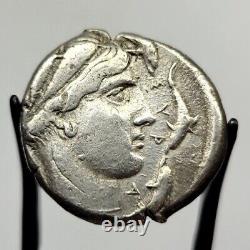
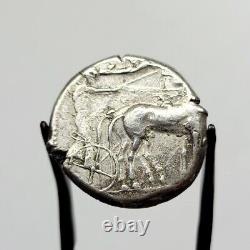
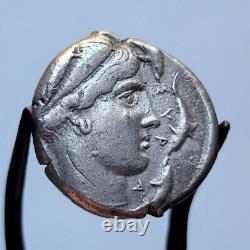
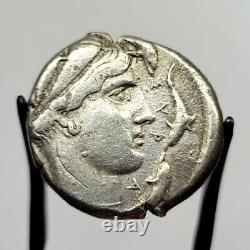
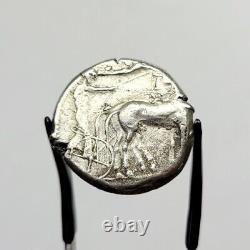
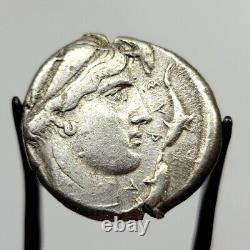
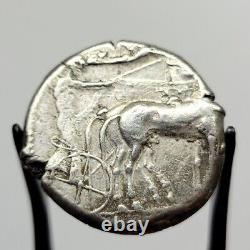
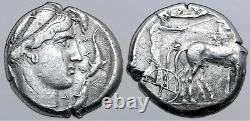


Thank you for looking at this beautiful example of an ancient Greek coin. It features amazing Hellenistic style with incredible details and rich history. As a patron figure of Syracuse, the head of Arethusa on the reverse surrounded by dolphins was a usual type on their coins. They are regarded as among the most famous and beautiful Ancient Greek coins. This is a great chance to own a piece of history, expand your collection, or give as a gift.
This coin is guaranteed authentic for life! Syracuse is a historic city on the Italian island of Sicily. The city is notable for its rich Greek and Roman history, culture, amphitheatres, architecture, and as the birthplace and home of the pre-eminent mathematician and engineer Archimedes.
Syracuse and its surrounding area have been inhabited since ancient times. Syracuse was founded in 734 or 733 BC by Greek settlers from Corinth and Tenea, led by Archias.The most acceptable theory is that the Phoenicians called it Sour-ha-Koussim, which means "Stone of the seagulls" from which would come the name of Syracuse. The nucleus of the ancient city was the small island of Ortygia. The settlers found the land fertile and the native tribes to be reasonably well-disposed to their presence. The city grew and prospered, and for some time stood as the most powerful Greek city anywhere in the Mediterranean.
Colonies were founded at Akrai (664 BC), Kasmenai (643 BC), Akrillai (7th century BC), Helorus (7th century BC) and Kamarina (598 BC). Syracuse grew considerably during the 6th and 5th centuries BC. Its walls encircled 120 hectares (300 acres) in the fifth century, but as early as the 470s BC the inhabitants started building outside the walls. The complete population of its territory approximately numbered 250,000 in 415 BC and the population size of the city itself was probably similar to Athens. Obverse: The biga is the two-horse chariot as used in ancient Greece and Rome for sport, transportation, and ceremonies.
Other animals may replace horses in art and occasionally for actual ceremonies. The term biga is also used by modern scholars for the similar chariots of other Indo-European cultures, particularly the two-horse chariot of the ancient Greeks and Celts.
Reverse: In Greek mythology, Arethusa was a nymph who fled from her home in Arcadia beneath the sea and came up as a fresh water fountain on the island of Ortygia in Syracuse, Sicily. The myth of her transformation begins in Arcadia when she came across a clear stream and began bathing, not knowing it was the river god Alpheus, who flowed down from Arcadia through Elis to the sea. He fell in love during their encounter, but she fled after discovering his presence and intentions, as she wished to remain a chaste attendant of Artemis.
After a long chase, she prayed to her goddess to ask for protection. Artemis hid her in a cloud, but Alpheus was persistent. She began to perspire profusely from fear, and soon transformed into a stream. Artemis then broke the ground allowing Arethusa another attempt to flee. Her stream traveled under the sea to the island of Ortygia, but Alpheus flowed through the sea to reach her and mingle with her waters.
Virgil augurs for Arethusa a salt-free passage beneath the sea on the condition that, before departing, she grant him songs about troubled loves, not those in her own future, but those of Virgil's friend and contemporary, the poet Cornelius Gallus, whom Virgil imagines dying from unrequited love beneath the famous mountains of Arcadia, Maenalus and Lycaeus. During Demeter's search for her daughter Persephone, Arethusa entreated Demeter to discontinue her punishment of Sicily for her daughter's disappearance. She told the goddess that while traveling in her stream below the earth, she saw her daughter as the queen of Hades. Circa 430 - 420 BC. Obverse: Charioteer, holding kentron and reins, driving walking biga to right; Nike flying to right above, crowning horses. Reverse: Head of Arethusa to right, hair tied with ribbon over head, S??? Size: 24mm, 17.5 grams. Boehringer 671 (V338/R458); SNG ANS 221 (same dies); Lockett 956 (same dies); HGC 2, 1320. Professional Numismatic Notes: Extra Fine, lustrous metal. All coins are guaranteed authentic for life. Please message me for any additional photos or questions. All items will come in a bubble wrap package to insure absolute protection for the contents inside.

